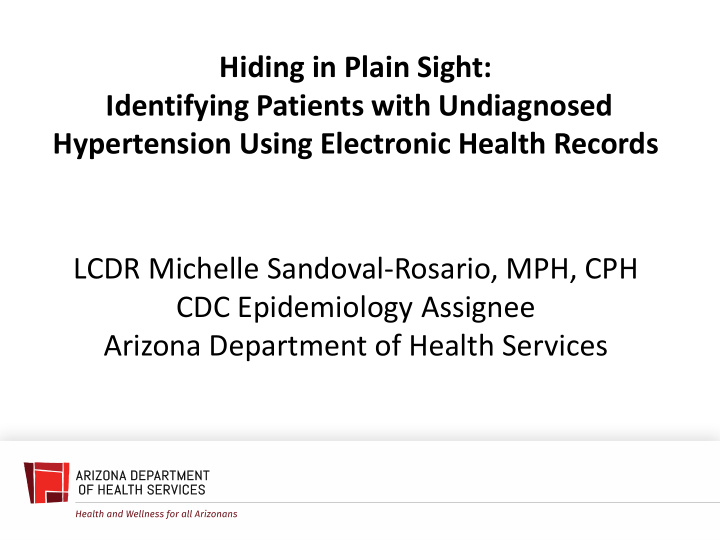



Hiding in Plain Sight: Identifying Patients with Undiagnosed Hypertension Using Electronic Health Records LCDR Michelle Sandoval-Rosario, MPH, CPH CDC Epidemiology Assignee Arizona Department of Health Services
Overview • Background • Electronic Health Records • CDC Grant • Clinical Definitions • Results • Challenges • Lessons Learned
Hypertension • 75 million US adults have hypertension (HTN) • Every 44 seconds, someone in the US has a heart attack • Every 4 minutes, someone dies of a stroke • 1 out of every 3 adults dies from cardiovascular disease National Health and Nutrition Examination Survey, 2013-2014 CDC Million Hearts
Uncontrolled Hypertension 34.6 M US Adults have uncontrolled HTN Aware and treated 11.5 M 16.1 M Aware and untreated "Unaware" 7 M National Health and Nutrition Examination Survey, 2013-2014 CDC Million Hearts
Unaware of Hypertension – A Closer Look 100% 90% 82.5% 81.8% 80% 70% 61.7% 60% 50% 40% 30% 20% 10% 0% Have Health Insurance Have a Usual Source of Care Have Received Care 2+ Times in Past Year National Health and Nutrition Examination Survey, 2013-2014 CDC Million Hearts
Hypertension Control How do you manage an Undiagnosed HTN patient you don’t know about? Identify Engage Diagnosed Manage BP potential patient in HTN HTN Control undx HTN care Identifying undiagnosed HTN Million Hearts
Steps for Finding and Addressing Undiagnosed Hypertension Establish Clinical Implement a Leverage EHR to Calculate the criteria for plan for find patients hypertension potential addressing the who meet prevalence in undiagnosed identified clinical criteria your practice HTN population Million Hearts
Purpose and Aim Improve detection Obtain the true and diagnosis of hypertension Improve awareness hypertensive population and control of HTN patients at health denominator at centers health center
Project Phase • Pre Five Year CDC Grant: – 2012 Meaningful Use Analysis of FQHC’s HIT Capacity • First started evaluating clinic’s capacity to track NQF measures • Included NQF 13 (HTN x2 Visits per year) • Multiple vendors; wide range of capacity and training • Partnerships – Collaborative relationship established with FQHCs, non-FQHC clinics, State QIO • Leveraging five Year CDC Grant Activities – Integrated the reporting of NQF 18 and 59 into most projects that occur in the healthcare setting • CHW projects • Team based care projects • Reinforced what was learned in the 2012 capacity analysis – some are ready, some are not
Year 3 Pilot and Year 4 • Year 3 Pilot – Selected non-FQHC community health center to pilot an EHR enhancement • Yuma, AZ. Creation of a virtual “portal” to create easy, chronic care management dashboards by patient or by specified patient population. Sorted by provider, condition, etc. – Results were very good. Clinic optimized information to target high risk patients. – Selected clinic to run reports on undiagnosed HTN after providing definitions and parameters. • Year 4 – Mirrored EHR portal development with additional clinics – Challenged five other health centers to report on undiagnosed HTN through inclusion of “required” performance measure reporting, in addition to their contractually obligated reports on NQF18, self management, etc.
Clinical Definitions • Proportion of adults in the state aware they have high blood pressure: – Numerator: the number of adults who have been diagnosed with HTN – Denominator: Total number of adult patients with HTN (diagnosed and undiagnosed) • Embedded algorithms into EHR to identify patients greater than 18 years old at risk for undiagnosed HTN – Definition: two or more non-consecutive blood pressure readings of >140/90 mm HG who did not have documentation of HTN
Year 3 Pilot Findings • Between 09/01/2015 – 07/31/2016 – 966 patients identified with HTN (diagnosed and undiagnosed) – 14% (138) undiagnosed – 51% Females and 93% Hispanic – 52% with controlled HTN
Year 4 Findings Five additional health systems throughout Arizona CHC Location # of patients with 2 or # diagnosed and Percent Controlled more blood pressure undiagnosed Undiagnosed blood readings ≥ 140/90 with High blood pressure (undiagnosed) pressure 1 Urban 77 256 30% 58% 2 Urban 92 386 24% 67% 3 Rural 159 2218 7% 80% 4 Urban 84 1773 5% 79% 5 Rural 46 4305 1% 86%
Challenges • Multiple definitions and algorithms • Health System’s EHR capacity or IT support • Lack of awareness/resources • Buy-in regarding methods/algorithm used • Time • Clinical criteria – Undiagnosed HTN – HTN Self Management Program
Lessons Learned Partnerships Develop a plan to address Identify EHR patients with capabilities high blood pressure Identifying Patients with Undiagnosed HTN Provide on-going Establish technical definition and assistance and clinical criteria guidance
ADHS Ongoing Efforts • Ongoing technical assistance/guidance to health systems • Developing clinical protocols to address undiagnosed hypertension • Collaborating with the American Heart Association Multicultural Office • Partnership with the Health Information Network of Arizona (HINaz) • Partnerships with safety net health systems (e.g. Paramedics, Emergency Medical Trauma professionals, Associations, FQHCs, other health centers) • Utilization of Community Health Workers to address undiagnosed hypertension
Electronic Health Records • Identifying individuals with undiagnosed and/or uncontrolled hypertension to target for outreach, follow up, or clinical management efforts • Identifying priority populations or geographic areas to target for intervention • Monitoring individuals to help them manage their blood pressure • Informing clinical quality improvement (QI) efforts • Monitoring population-level trends and measures over time • Reporting on clinical quality measures
Acknowledgements/Co-Authors Arizona Department of Health Services Anna Alonzo Omar Contreras, MPH David Heath, MA Teresa Manygoats, MPA Reginal Center for Border Health Amanda Aguirre, MPH Marisol Penuelas Centers For Disease Control and Prevention CDR Timothy Cunningham, ScD, SM, FACE
Thank you! Questions/ Comments? Michelle.Sandoval-Rosario@azdhs.gov
Recommend
More recommend